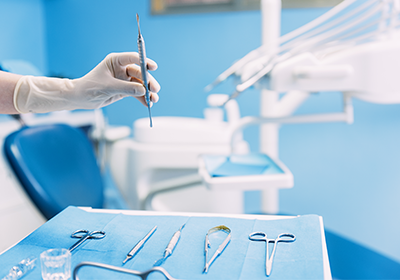What is gum disease?
The term “periodontal” means around the tooth. Gum disease - also known as periodontal disease - a is a common inflammatory condition that affects the supporting and surrounding soft tissues of the tooth, eventually affecting the jawbone itself in the disease’s most advanced stages.
Gingivitis
Gum disease is most often preceded by gingivitis, the first stage of periodontal disease. This occurs when a bacterial infection affects the gums when the toxins contained in plaque begin to irritate and inflame gum tissue. Once this bacterial infection settles in the gum pockets between the teeth, it becomes much more difficult to remove and treat. If the disease is caught in the early stages of gingivitis, and no damage has been done, one to two professional cleanings will be recommended. You will also be given instructions on improving your daily oral hygiene habits and encouraged to have regular teeth cleanings.
What are other types of gum disease?
If left untreated, gingivitis can spread below the gum line. When gums become irritated by the toxins contained in plaque, a chronic inflammatory response causes the body to break down and destroy its own bone and soft tissue. You may experience little or no symptoms; however, deepening pockets between the gums and teeth are generally indicative that soft tissue and bone is being destroyed. This can cause shifting teeth, loose teeth, and eventually tooth loss. Periodontal disease is one of the leading causes of tooth loss among adults in the developed world, and should always be promptly treated and taken very seriously.
Diagnosing gum disease
Periodontal/gum disease is diagnosed by your dentist or dental hygienist during your routine exam. A periodontal probe (a small dental instrument) is gently used to measure the sulcus (pocket or space) between the tooth and the gums. The depth of a healthy sulcus measures three millimeters or less, and does not bleed. The periodontal probe helps indicate if pockets are deeper than three millimeters. As periodontal disease progresses, the pockets usually get deeper. Your dentist will use pocket depths, the amount of bleeding, inflammation, tooth mobility, and more to make a diagnosis.
What are some common treatments for periodontal disease?
There are surgical and nonsurgical treatments for periodontal disease that your dentist may choose to perform, depending on the exact condition of your teeth, gums, and jawbone. A complete periodontal exam of your mouth will be completed before any treatment plan is performed or recommended. Here are some treatment options:
- Scaling and root-planning: In order to preserve the health of gum tissue, the bacteria and calculus (tartar) which initially caused the infection must be removed. The gum pockets will be cleaned and treated with antibiotics as necessary to help alleviate the infection. A prescription mouthwash may be incorporated into daily cleaning routines. If the pockets do not heal after scaling and root-planning, periodontal surgery may be needed to reduce pocket depths, making teeth easier to clean.
- Tissue regeneration: When the bone and gum tissue have been destroyed, regrowth can be actively encouraged using grafting procedures. A membrane may be inserted into the affected areas to assist in the regeneration process.
- Pocket elimination surgery: Pocket elimination surgery - also known as flap surgery - is a surgical treatment which can be performed to reduce the pocket size between the teeth and gums. Surgery on the jawbone is another option which serves to eliminate indentations in the bone which foster the colonization of bacteria.
- Dental implants: When teeth have been lost due to periodontal disease, the aesthetics and functionality of the mouth can be restored by implanting prosthetic teeth into the jawbone. Tissue regeneration procedures may be required prior to the placement of a dental implant in order to strengthen the bone.
As you can see from some of the recommended treatment options above, your best bet is to ward off gum disease altogether by taking good care of your teeth and gums at home by brushing and flossing daily, and visiting your dentist and hygienist for regular cleanings and exams.
If you have any questions about gum disease as it relates to your mouth health, give us a call. We’d be happy to answer any questions you may have, or book you in for a dental exam - 780.998.7165.

Dr. Patricia Kenny
Dr. Jordan Rattai
Dr. Lindsay Patterson
Dr. Payal Kumar
201 - 10010 88 Ave.
Fort Saskatchewan, AB
T8L 0A8
